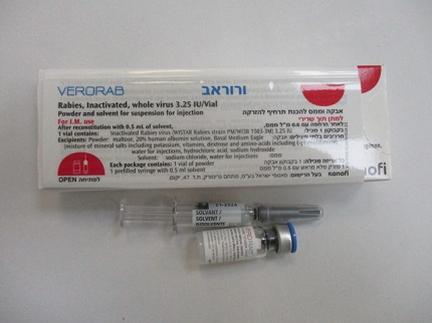Quest for the right Drug

ורוראב VERORAB (RABIES, INACTIVATED, WHOLE VIRUS)
תרופה במרשם
תרופה בסל
נרקוטיקה
ציטוטוקסיקה
צורת מתן:
תוך-שרירי : I.M
צורת מינון:
אבקה וממס להכנת תרחיף להזרקה : POWDER AND SOLVENT FOR SUSPENSION FOR INJECTION
עלון לרופא
מינוניםPosology התוויות
Indications תופעות לוואי
Adverse reactions התוויות נגד
Contraindications אינטראקציות
Interactions מינון יתר
Overdose הריון/הנקה
Pregnancy & Lactation אוכלוסיות מיוחדות
Special populations תכונות פרמקולוגיות
Pharmacological properties מידע רוקחי
Pharmaceutical particulars אזהרת שימוש
Special Warning עלון לרופא
Physicians Leaflet
Special Warning : אזהרת שימוש
4.4. Special warnings and precautions for use Traceability In order to improve the traceability of biological medicinal products, the name of the administered product should be clearly recorded. It is recommended to record the batch number as well. Special warnings Like all vaccines, Verorab may not protect 100% of those vaccinated. To be used with caution in individuals with a known allergy to polymyxin B, streptomycin or neomycin (present in trace amounts in the vaccine). or to an antibiotic of the same class. Precautions for use Recommendations relating to the injection regimen should be followed exactly. Serological tests (in order to assess the seroconversion of subjects) should be used in accordance with official recommendations. When the vaccine is administered to subjects with known immunodeficiency due to an immunosuppressive disease or concomitant immunosuppressive treatment (including corticosteroids), serological tests should be performed 2 to 4 weeks after vaccination in order to ensure a protective immune response has been induced. In the case of post-exposure vaccination, a complete course of vaccination should be administered. Rabies immunoglobulins should also be administered in combination with the vaccine in the event of any category II and III exposure (see Section 4.2).Do not inject by the intravascular route: make sure the needle does not penetrate a blood vessel. As with any vaccine injection, in the event of a rare anaphylactic reaction occurring after administration of the vaccine, appropriate medical treatment should be available immediately, and the patient should be monitored, particularly in post- exposure vaccination in subjects with known hypersensitivity to polymyxin B, streptomycin, or neomycin, or to an antibiotic of the same class. As with any vaccine injection, Verorab should be administered with caution in patients with thrombocytopaenia or coagulation disorders, as intramuscular injection may lead to bleeding in these subjects. Anxiety-related reactions, including vasovagal reactions (syncope), hyperventilation or stress-related reactions, may occur after, or even before, any vaccination, as a psychogenic reaction to the injection with a needle. This may be accompanied by several neurological signs, such as a transient vision disorder and paraesthesia. It is important that measures are in place to prevent injury in the event of fainting. Verorab contains phenylalanine, potassium and sodium VERORAB contains 4.1 micrograms of phenylalanine per 0.5 mL dose equivalent to 0.068 micrograms/kg in a 60 kg person. Phenylalanine may be dangerous for individuals with phenylketonuria (PKU), a rare genetic disease characterised by a defect in the elimination of phenylalanine and its accumulation in the body. Verorab contains less than 1 mmol (39 mg) of potassium, and less than 1 mmol (23 mg) of sodium per dose; that is, it is considered to be essentially "potassium-free" and "sodium-free". Paediatric population The potential risk of apnoea and the need for respiratory monitoring for 48-72 hours should be carefully considered when administering the primary vaccination doses in very premature infants (born ≤ 28 weeks of pregnancy gestation or less) and particularly for those with a history of respiratory immaturity.
Effects on Driving

שימוש לפי פנקס קופ''ח כללית 1994
לא צוין
תאריך הכללה מקורי בסל
לא צוין
הגבלות
לא צוין
מידע נוסף
